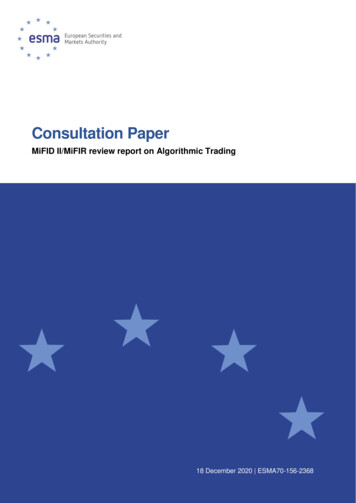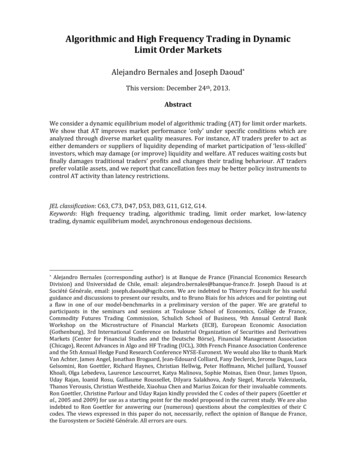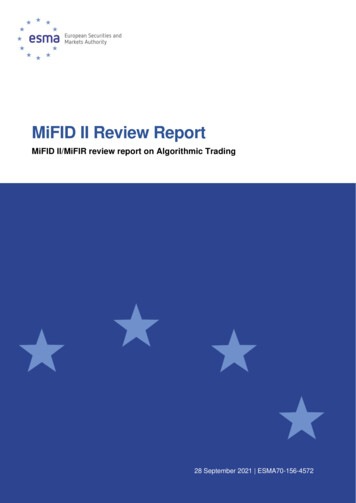
Transcription
Playing Games with Algorithms:Algorithmic Combinatorial Game Theory Erik D. Demaine†Robert A. Hearn‡AbstractCombinatorial games lead to several interesting, clean problems in algorithms and complexitytheory, many of which remain open. The purpose of this paper is to provide an overviewof the area to encourage further research. In particular, we begin with general backgroundin Combinatorial Game Theory, which analyzes ideal play in perfect-information games, andConstraint Logic, which provides a framework for showing hardness. Then we survey resultsabout the complexity of determining ideal play in these games, and the related problems ofsolving puzzles, in terms of both polynomial-time algorithms and computational intractabilityresults. Our review of background and survey of algorithmic results are by no means complete,but should serve as a useful primer.1IntroductionMany classic games are known to be computationally intractable (assuming P 6 NP): one-playerpuzzles are often NP-complete (as in Minesweeper) or PSPACE-complete (as in Rush Hour), andtwo-player games are often PSPACE-complete (as in Othello) or EXPTIME-complete (as in Checkers, Chess, and Go). Surprisingly, many seemingly simple puzzles and games are also hard. Otherresults are positive, proving that some games can be played optimally in polynomial time. In somecases, particularly with one-player puzzles, the computationally tractable games are still interestingfor humans to play.We begin by reviewing some basics of Combinatorial Game Theory in Section 2, which givestools for designing algorithms, followed by reviewing the relatively new theory of Constraint Logic inSection 3, which gives tools for proving hardness. In the bulk of this paper, Sections 4–6 survey manyof the algorithmic and hardness results for combinatorial games and puzzles. Section 7 concludeswith a small sample of difficult open problems in algorithmic Combinatorial Game Theory.Combinatorial Game Theory is to be distinguished from other forms of game theory arisingin the context of economics. Economic game theory has many applications in computer scienceas well, for example, in the context of auctions [dVV03] and analyzing behavior on the Internet[Pap01]. A preliminary version of this paper appears in the Proceedings of the 26th International Symposium on Mathematical Foundations of Computer Science, Lecture Notes in Computer Science 2136, Czech Republic, August 2001,pages 18–32. The latest version can be found at http://arXiv.org/abs/cs.CC/0106019.†MIT Computer Science and Artificial Intelligence Laboratory, 32 Vassar St., Cambridge, MA 02139, USA,edemaine@mit.edu‡Neukom Institute for Computational Sciece, Dartmouth College, Sudikoff Hall, HB 6255, Hanover, NH 03755,USA, robert.a.hearn@dartmouth.edu1
2Combinatorial Game TheoryA combinatorial game typically involves two players, often called Left and Right, alternating playin well-defined moves. However, in the interesting case of a combinatorial puzzle, there is onlyone player, and for cellular automata such as Conway’s Game of Life, there are no players. In allcases, no randomness or hidden information is permitted: all players know all information aboutgameplay (perfect information). The problem is thus purely strategic: how to best play the gameagainst an ideal opponent.It is useful to distinguish several types of two-player perfect-information games [BCG04, pp. 14–15]. A common assumption is that the game terminates after a finite number of moves (the gameis finite or short), and the result is a unique winner. Of course, there are exceptions: some games(such as Life and Chess) can be drawn out forever, and some games (such as tic-tac-toe and Chess)define ties in certain cases. However, in the combinatorial-game setting, it is useful to define thewinner as the last player who is able to move; this is called normal play. If, on the other hand, thewinner is the first player who cannot move, this is called misère play. (We will normally assumenormal play.) A game is loopy if it is possible to return to previously seen positions (as in Chess,for example). Finally, a game is called impartial if the two players (Left and Right) are treatedidentically, that is, each player has the same moves available from the same game position; otherwisethe game is called partizan.A particular two-player perfect-information game without ties or draws can have one of fouroutcomes as the result of ideal play: player Left wins, player Right wins, the first player to movewins (whether it is Left or Right), or the second player to move wins. One goal in analyzing twoplayer games is to determine the outcome as one of these four categories, and to find a strategy forthe winning player to win. Another goal is to compute a deeper structure to games described inthe remainder of this section, called the value of the game.A beautiful mathematical theory has been developed for analyzing two-player combinatorialgames. A new introductory book on the topic is Lessons in Play by Albert, Nowakowski, andWolfe [ANW07]; the most comprehensive reference is the book Winning Ways by Berlekamp,Conway, and Guy [BCG04]; and a more mathematical presentation is the book On Numbers andGames by Conway [Con01]. See also [Con77, Fra96] for overviews and [Fra07] for a bibliography.The basic idea behind the theory is simple: a two-player game can be described by a rooted tree,where each node has zero or more left branches corresponding to options for player Left to move andzero or more right branches corresponding to options for player Right to move; leaves correspondto finished games, with the winner determined by either normal or misère play. The interestingparts of Combinatorial Game Theory are the several methods for manipulating and analyzing suchgames/trees. We give a brief summary of some of these methods in this section.2.1Conway’s Surreal NumbersA richly structured special class of two-player games are John H. Conway’s surreal numbers 1 [Con01,Knu74, Gon86, All87], a vast generalization of the real and ordinal number systems. Basically, asurreal number {L R} is the “simplest” number larger than all Left options (in L) and smallerthan all Right options (in R); for this to constitute a number, all Left and Right options must benumbers, defining a total order, and each Left option must be less than each Right option. See[Con01] for more formal definitions.For example, the simplest number without any larger-than or smaller-than constraints, denoted1The name “surreal numbers” is actually due to Knuth [Knu74]; see [Con01].2
{ }, is 0; the simplest number larger than 0 and without smaller-than constraints, denoted {0 },is 1; and the simplest number larger than 0 and 1 (or just 1), denoted {0, 1 }, is 2. This methodcan be used to generate all natural numbers and indeed all ordinals. On the other hand, thesimplest number less than 0, denoted { 0}, is 1; similarly, all negative integers can be generated.Another example is the simplest number larger than 0 and smaller than 1, denoted {0 1}, whichis 21 ; similarly, all dyadic rationals can be generated. After a countably infinite number of suchconstruction steps, all real numbers can be generated; after many more steps, the surreals are allnumbers that can be generated in this way.Surreal numbers form a field, so in particular they are totally ordered, and support the operations of addition, subtraction, multiplication, division, roots, powers, and even integration in many situations. (For those familiar with ordinals, contrast with surreals which define ω 1, 1/ω, ω,etc.) As such, surreal numbers are useful in their own right for cleaner forms of analysis; see, e.g.,[All87].What is interesting about the surreals from the perspective of combinatorial game theory is thatthey are a subclass of all two-player perfect-information games, and some of the surreal structure,such as addition and subtraction, carries over to general games. Furthermore, while games are nottotally ordered, they can still be compared to some surreal numbers and, amazingly, how a gamecompares to the surreal number 0 determines exactly the outcome of the game. This connection isdetailed in the next few paragraphs.First we define some algebraic structure of games that carries over from surreal numbers; seeTable 1 for formal definitions. Two-player combinatorial games, or trees, can simply be representedas {L R} where, in contrast to surreal numbers, no constraints are placed on L and R. Thenegation of a game is the result of reversing the roles of the players Left and Right throughout thegame. The (disjunctive) sum of two (sub)games is the game in which, at each player’s turn, theplayer has a binary choice of which subgame to play, and makes a move in precisely that subgame.A partial order is defined on games recursively: a game x is less than or equal to a game y if everyLeft option of x is less than y and every Right option of y is more than x. (Numeric) equality isdefined by being both less than or equal to and more than or equal to. Strictly inequalities, as usedin the definition of less than or equal to, are defined in the obvious manner.Note that while { 1 1} 0 { } in terms of numbers, { 1 1} and { } denote differentgames (lasting 1 move and 0 moves, respectively), and in this sense are equal in value but notidentical symbolically or game-theoretically. Nonetheless, the games { 1 1} and { } have thesame outcome: the second player to move wins.Amazingly, this holds in general: two equal numbers represent games with equal outcome (underideal play). In particular, all games equal to 0 have the outcome that the second player to movewins. Furthermore, all games equal to a positive number have the outcome that the Left playerwins; more generally, all positive games (games larger than 0) have this outcome. Symmetrically,all negative games have the outcome that the Right player wins (this follows automatically bythe negation operation). Examples of zero, positive, and negative games are the surreal numbersthemselves; an additional example is described below.There is one outcome not captured by the characterization into zero, positive, and negativegames: the first player to move wins. To find such a game we must obviously look beyond thesurreal numbers. Furthermore, we must look for games G that are incomparable with zero (noneof G 0, G 0, or G 0 hold); such games are called fuzzy with 0, denoted G k 0.An example of a game that is not a surreal number is {1 0}; there fails to be a number strictlybetween 1 and 0 because 1 0. Nonetheless, {1 0} is a game: Left has a single move leading togame 1, from which Right cannot move, and Right has a single move leading to game 0, from which3
Let x {xL xR } be a game. x y precisely if every xL y and every y R x. x y precisely if x y and x y; otherwise x 6 y. x y precisely if x y and x 6 y, or equivalently, x y and x 6 y. x { xR xL }. x y {xL y, x y L xR y, x y R }. x is impartial precisely if xL and xR are identical sets and recursively everyposition ( xL xR ) is impartial. A one-pile Nim game is defined by n { 0, . . . , (n 1) 0, . . . , (n 1)},together with 0 0.Table 1: Formal definitions of some algebra on two-player perfect-information games. In particular, all ofthese notions apply to surreal numbers.Left cannot move. Thus, in either case, the first player to move wins. The claim above implies that{1 0} k 0. Indeed, {1 0} k x for all surreal numbers x, 0 x 1. In contrast, x {1 0} forall x 0 and {1 0} x for all 1 x. In general it holds that a game is fuzzy with some surrealnumbers in an interval [ n, n] but comparable with all surreals outside that interval. Anotherexample of a game that is not a number is {2 1}, which is positive ( 0), and hence Right wins,but fuzzy with numbers in the range [1, 2].For brevity we omit many other useful notions in Combinatorial Game Theory, such as additional definitions of summation, super-infinitesimal games and , mass, temperature, thermographs, the simplest form of a game, remoteness, and suspense; see [BCG04, Con01].2.2Sprague-Grundy TheoryA celebrated result in Combinatorial Game Theory is the characterization of impartial two-playerperfect-information games, discovered independently in the 1930’s by Sprague [Spr36] and Grundy[Gru39]. Recall that a game is impartial if it does not distinguish between the players Left andRight (see Table 1 for a more formal definition). The Sprague-Grundy theory [Spr36, Gru39, Con01,BCG04] states that every finite impartial game is equivalent to an instance of the game of Nim,characterized by a single natural number n. This theory has since been generalized to all impartialgames by generalizing Nim to all ordinals n; see [Con01, Smi66].Nim [Bou02] is a game played with several heaps, each with a certain number of tokens. A Nimgame with a single heap of size n is denoted by n and is called a nimber. During each move aplayer can pick any pile and reduce it to any smaller nonnegative integer size. The game ends whenall piles have size 0. Thus, a single pile n can be reduced to any of the smaller piles 0, 1, . . . , (n 1). Multiple piles in a game of Nim are independent, and hence any game of Nim is a sumof single-pile games n for various values of n. In fact, a game of Nim with k piles of sizes n1 , n2 ,. . . , nk is equivalent to a one-pile Nim game n, where n is the binary XOR of n1 , n2 , . . . , nk . Asa consequence, Nim can be played optimally in polynomial time (polynomial in the encoding sizeof the pile sizes).4
Even more surprising is that every impartial two-player perfect-information game has the samevalue as a single-pile Nim game, n for some n. The number n is called the G-value, Grundyvalue, or Sprague-Grundy function of the game. It is easy to define: suppose that game x has koptions y1 , . . . , yk for the first move (independent of which player goes first). By induction, we cancompute y1 n1 , . . . , yk nk . The theorem is that x equals n where n is the smallest naturalnumber not in the set {n1 , . . . , nk }. This number n is called the minimum excluded value or mexof the set. This description has also assumed that the game is finite, but this is easy to generalize[Con01, Smi66].The Sprague-Grundy function can increase by at most 1 at each level of the game tree, andhence the resulting nimber is linear in the maximum number of moves that can be made in thegame; the encoding size of the nimber is only logarithmic in this count. Unfortunately, computingthe Sprague-Grundy function for a general game by the obvious method uses time linear in thenumber of possible states, which can be exponential in the nimber itself.Nonetheless, the Sprague-Grundy theory is extremely helpful for analyzing impartial two-playergames, and for many games there is an efficient algorithm to determine the nimber. Examples include Nim itself, Kayles, and various generalizations [GS56b]; and Cutcake and Maundy Cake[BCG04, pp. 24–27]. In all of these examples, the Sprague-Grundy function has a succinct characterization (if somewhat difficult to prove); it can also be easily computed using dynamic programming.The Sprague-Grundy theory seems difficult to generalize to the superficially similar case ofmisère play, where the goal is to be the first player unable to move. Certain games have beensolved in this context over the years, including Nim [Bou02]; see, e.g., [Fer74, GS56a]. Recentlya general theory has emerged for tackling misère combinatorial games, based on commutativemonoids called “misère quotients” that localize the problem to certain restricted game scenarios.This theory was introduced by Plambeck [Pla05] and further developed by Plambeck and Siegel[PS07]. For good descriptions of the theory, see Plambeck’s survey [Plaa], Siegel’s lecture notes[Sie06], and a webpage devoted to the topic [Plab].2.3Strategy StealingAnother useful technique in Combinatorial Game Theory for proving that a particular player mustwin is strategy stealing. The basic idea is to assume that one player has a winning strategy, andprove that in fact the other player has a winning strategy based on that strategy. This contradictionproves that the second player must in fact have a winning strategy. An example of such an argumentis given in Section 4.1. Unfortunately, such a proof by contradiction gives no indication of what thewinning strategy actually is, only that it exists. In many situations, such as the one in Section 4.1,the winner is known but no polynomial-time winning strategy is known.2.4PuzzlesThere is little theory for analyzing combinatorial puzzles (one-player games) along the lines of thetwo-player theory summarized in this section. We present one such viewpoint here. In most puzzles,solutions subdivide into a sequence of moves. Thus, a puzzle can be viewed as a tree, similar to atwo-player game except that edges are not distinguished between Left and Right. With the viewthat the game ends only when the puzzle is solved, the goal is then to reach a position from whichthere are no valid moves (normal play). Loopy puzzles are common; to be more explicit, repeatedsubtrees can be converted into self-references to form a directed graph, and losing terminal positionscan be given explicit loops to themselves.5
A consequence of the above view is that a puzzle is basically an impartial two-player game exceptthat we are not interested in the outcome from two players alternating in moves. Rather, questionsof interest in the context of puzzles are (a) whether a given puzzle is solvable, and (b) finding thesolution with the fewest moves. An important open direction of research is to develop a generaltheory for resolving such questions, similar to the two-player theory.3Constraint LogicCombinatorial Game Theory provides a theoretical framework for giving positive algorithmic resultsfor games, but does not naturally accommodate puzzles. In contrast, negative algorithmic results—hardness and completeness within computational complexity classes—are more uniform: puzzlesand games have analogous prototypical proof structures. Furthermore, a relatively new theorycalled Constraint Logic attempts to tie together a wide range of hardness proofs for both puzzlesand games.Proving that a problem is hard within a particular complexity class (like NP, PSPACE, or EXPTIME) almost always involves a reduction to the problem from a known hard problem within theclass. For example, the canonical problem to reduce from for NP-hardness is Boolean Satisfiability(SAT) [Coo71]. Reducing SAT to a puzzle of interest proves that that puzzle is NP-hard. Similarly,the canonical problem to reduce from for PSPACE-hardness is Quantified Boolean Formulas (QBF)[SM73].Constraint Logic [DH08] is a useful tool for showing hardness of games and puzzles in a varietyof settings that has emerged in recent years. Indeed, many of the hardness results mentioned inthis survey are based on reductions from Constraint Logic. Constraint Logic is a family of gameswhere players reverse edges on a planar directed graph while satisfying vertex in-flow constraints.Each edge has a weight of 1 or 2. Each vertex has degree 3 and requires that the sum of the weightsof inward-directed edges is at least 2. Vertices may be restricted to two types: And vertices haveincident edge weights of 1, 1, and 2; and Or vertices have incident edge weights of 2, 2, and 2. Aplayer’s goal is to eventually reverse a given edge.This game family can be interpreted in many game-theoretic settings, ranging from zero-playerautomata to multiplayer games with hidden information. In particular, there are natural versionsof Constraint Logic corresponding to one-player games (puzzles) and two-player games, both ofbounded and unbounded length. (Here we refer to whether the length of the game is bounded bya polynomial function of the board size. Typically, bounded games are nonloopy while unboundedgames are loopy.) These games have the expected complexities: one-player bounded games areNP-complete; one-player unbounded games and two-player bounded games are PSPACE-complete;and two-player unbounded games are EXPTIME-complete.What makes Constraint Logic specially suited for game and puzzle reductions is that the problems are already in form similar to many games. In particular, the fact that the games are playedon planar graphs means that the reduction does not usually need a crossover gadget, whereashistorically crossover gadgets have often been the complex crux of a game hardness proof.Historically, Constraint Logic arose as a simplification of the “Generalized Rush-Hour Logic”of Flake and Baum [FB02]. The resulting one-player unbounded setting, called NondeterministicConstraint Logic [HD02, HD05], was later generalized to other game categories [Hea06b, DH08].6
4Algorithms for Two-Player GamesMany bounded-length two-player games are PSPACE-complete. This is fairly natural becausegames are closely related to Boolean expressions with alternating quantifiers (for which decidingsatisfiability is PSPACE-complete): there exists a move for Left such that, for all moves for Right,there exists another move for Left, etc. A PSPACE-completeness result has two consequences.First, being in PSPACE means that the game can be played optimally, and typically all positionscan be enumerated, using possibly exponential time but only polynomial space. Thus such gameslend themselves to a somewhat reasonable exhaustive search for small enough sizes. Second, thegames cannot be solved in polynomial time unless P PSPACE, which is even “less likely” thanP equaling NP.On the other hand, unbounded-length two-players games are often EXPTIME-complete. Such aresult is one of the few types of true lower bounds in complexity theory, implying that all algorithmsrequire exponential time in the worst case.In this section we briefly survey many of these complexity results and related positive results.See also [Epp] for a related survey and [Fra07] for a bibliography.4.1HexHex [BCG04, pp. 743–744] is a game designed by Piet Hein andplayed on a diamond-shaped hexagonal board; see Figure 1. Players take turns filling in empty hexagons with their color. Thegoal of a player is to connect the opposite sides of their color withhexagons of their color. (In the figure, one player is solid and theother player is dotted.) A game of Hex can never tie, because if allhexagons are colored arbitrarily, there is precisely one connectingFigure 1: A 5 5 Hex board.path of an appropriate color between opposite sides of the board.John Nash [BCG04, p. 744] proved that the first player to move can win by using a strategystealing argument (see Section 2.3). Suppose that the second player has a winning strategy, andassume by symmetry that Left goes first. Left selects the first hexagon arbitrarily. Now Right is tomove first and Left is effectively the second player. Thus, Left can follow the winning strategy forthe second player, except that Left has one additional hexagon. But this additional hexagon canonly help Left: it only restricts Right’s moves, and if Left’s strategy suggests filling the additionalhexagon, Left can instead move anywhere else. Thus, Left has a winning strategy, contradictingthat Right did, and hence the first player has a winning strategy. However, it remains open to givea polynomial characterization of a winning strategy for the first player.In perhaps the first PSPACE-hardness result for “interesting” games, Even and Tarjan [ET76]proved that a generalization of Hex to graphs is PSPACE-complete, even for maximum-degree-5graphs. Specifically, in this graph game, two vertices are initially colored Left, and players taketurns coloring uncolored vertices in their own color. Left’s goal is to connect the two initially Leftvertices by a path, and Right’s goal is to prevent such a path. Surprisingly, the closely relatedproblem in which players color edges instead of vertices can be solved in polynomial time; thisgame is known as the Shannon switching game [BW70]. A special case of this game is Bridgit orGale, invented by David Gale [BCG04, p. 744], in which the graph is a square grid and Left’s goalis to connect a vertex on the top row with a vertex on the bottom row. However, if the graph inShannon’s switching game has directed edges, the game again becomes PSPACE-complete [ET76].A few years later, Reisch [Rei81] proved the stronger result that determining the outcome ofa position in Hex is PSPACE-complete on a normal diamond-shaped board. The proof is quite7
different from the general graph reduction of Even and Tarjan [ET76], but the main milestone isto prove that Hex is PSPACE-complete for planar graphs.4.2More Games on Graphs: Kayles, Snort, Geography, Peek, and InteractiveHamiltonicityThe second paper to prove PSPACE-hardness of “interesting” games is by Schaefer [Sch78]. Thiswork proposes over a dozen games and proves them PSPACE-complete. Some of the games involvepropositional formulas, others involve collections of sets, but perhaps the most interesting are thoseinvolving graphs. Two of these games are generalizations of “Kayles”, and another is a graphtraversal game called Edge Geography.Kayles [BCG04, pp. 81–82] is an impartial game, designed independently by Dudeney and SamLoyd, in which bowling pins are lined up on a line. Players take turns bowling with the propertythat exactly one or exactly two adjacent pins are knocked down (removed) in each move. Thus,most moves split the game into a sum of two subgames. Under normal play, Kayles can be solvedin polynomial time using the Sprague-Grundy theory; see [BCG04, pp. 90–91], [GS56b].Node Kayles is a generalization of Kayles to graphs in which each bowl “knocks down” (removes)a desired vertex and all its neighboring vertices. (Alternatively, this game can be viewed as twoplayers finding an independent set.) Schaefer [Sch78] proved that deciding the outcome of thisgame is PSPACE-complete. The same result holds for a partizan version of node Kayles, in whichevery node is colored either Left or Right and only the corresponding player can choose a particularnode as the primary target.Geography is another graph game, or rather game family, that is special from a techniquespoint of view: it has been used as the basis of many other PSPACE-hardness reductions for gamesdescribed in this section. The motivating example of the game is players taking turns namingdistinct geographic locations, each starting with the same letter with which the previous nameended. More generally, Geography consists of a directed graph with one node initially containinga token. Players take turns moving the token along a directed edge. In Edge Geography, that edgeis then erased; in Vertex Geography, the vertex moved from is then erased. (Confusingly, in theliterature, each of these variants is frequently referred to as simply “Geography” or “GeneralizedGeography”.)Schaefer [Sch78] established that Edge Geography (a game suggested by R. M. Karp) is PSPACEcomplete; Lichtenstein and Sipser [LS80] showed that Vertex Geography (which more closelymatches the motivating example above) is also PSPACE-complete. Nowakowski and Poole [NP96]have solved special cases of Vertex Geography when the graph is a product of two cycles.One may also consider playing either Geography game on an undirected graph. Fraenkel,Scheinerman, and Ullman [FSU93] show that Undirected Vertex Geography can be solved in polynomial time, whereas Undirected Edge Geography is PSPACE-complete, even for planar graphswith maximum degree 3. If the graph is bipartite then Undirected Edge Geography is also solvablein polynomial time.One consequence of partizan node Kayles being PSPACE-hard is that deciding the outcomein Snort is PSPACE-complete on general graphs [Sch78]. Snort [BCG04, pp. 145–147] is a gamedesigned by S. Norton and normally played on planar graphs (or planar maps). In any case, playerstake turns coloring vertices (or faces) in their own color such that only equal colors are adjacent.Generalized hex (the vertex Shannon switching game), node Kayles, and Vertex Geography havealso been analyzed recently in the context of parameterized complexity. Specifically, the problemof deciding whether the first player can win within k moves, where k is a parameter to the problem,8
is AW[ ]-complete [DF97, ch. 14].Stockmeyer and Chandra [SC79] were the first to prove combinatorial games to be EXPTIMEhard. They established EXPTIME-completeness for a class of logic games and two graph games.Here we describe an example of a logic game in the class, and one of the graph games; the othergraph game is described in the next section. One logic game, called Peek, involves a box containingseveral parallel rectangular plates. Each plate (1) is colored either Left or Right except for oneownerless plate, (2) has circular holes carved in particular (known) positions, and (3) can be slidto one of two positions (fully in the box or partially outside the box). Players take turns eitherpassing or changing the position of one of their plates. The winner is the first player to cause ahole in every plate to be aligned along a common vertical line. A second game involves a graphin which some edges are colored Left and some edges are colored Right, and initially some edgesare “in” while the others are “out”. Players take turns either passing or changing one edge from“out” to “in” or vice versa. The winner is the first player to cause the graph of “in” edges to havea Hamiltonian cycle. (Both of these games can be rephrased under normal play by defining thereto be no valid moves from positions having aligned holes or Hamiltonian cycles.)4.3Games of Pursuit: Annihilation, Remove, Capture, Contrajunctive, Blocking, Target, and Cops and RobbersThe next suite of graph games essentially bega
Constraint Logic, which provides a framework for showing hardness. Then we survey results . A beautiful mathematical theory has been developed for analyzing two-player combinatorial games. A new introductory book on the topic is Lessons in Play by Albert, Nowakowski, and










